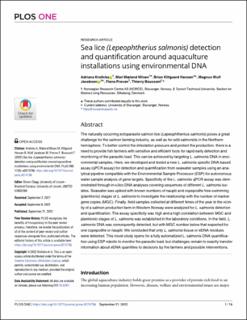| dc.contributor.author | Krolicka, Adriana | |
| dc.contributor.author | Nilsen, Mari Mæland | |
| dc.contributor.author | Hansen, Brian Klitgaard | |
| dc.contributor.author | Wulf Jacobsen, Lars Magnus | |
| dc.contributor.author | Provan, Fiona | |
| dc.contributor.author | Baussant, Thierry | |
| dc.date.accessioned | 2023-09-20T08:39:05Z | |
| dc.date.available | 2023-09-20T08:39:05Z | |
| dc.date.created | 2022-09-15T10:53:47Z | |
| dc.date.issued | 2022 | |
| dc.identifier.issn | 1932-6203 | |
| dc.identifier.uri | https://hdl.handle.net/11250/3090705 | |
| dc.description.abstract | The naturally occurring ectoparasite salmon lice (Lepeophtherirus salmonis) poses a great challenge for the salmon farming industry, as well as for wild salmonids in the Northern hemisphere. To better control the infestation pressure and protect the production, there is a need to provide fish farmers with sensitive and efficient tools for rapid early detection and monitoring of the parasitic load. This can be achieved by targeting L. salmonis DNA in environmental samples. Here, we developed and tested a new L. salmonis specific DNA-based assay (qPCR assay) for detection and quantification from seawater samples using an analytical pipeline compatible with the Environmental Sample Processor (ESP) for autonomous water sample analysis of gene targets. Specificity of the L. salmonis qPCR assay was demonstrated through in-silico DNA analyses covering sequences of different L. salmonis isolates. Seawater was spiked with known numbers of nauplii and copepodite free-swimming (planktonic) stages of L. salmonis to investigate the relationship with the number of marker gene copies (MGC). Finally, field samples collected at different times of the year in the vicinity of a salmon production farm in Western Norway were analyzed for L. salmonis detection and quantification. The assay specificity was high and a high correlation between MGC and planktonic stages of L. salmonis was established in the laboratory conditions. In the field, L. salmonis DNA was consequently detected, but with MGC number below that expected for one copepodite or nauplii. We concluded that only L. salmonis tissue or eDNA residues were detected. This novel study opens for a fully automatized L. salmonis DNA quantification using ESP robotic to monitor the parasitic load, but challenges remain to exactly transfer information about eDNA quantities to decisions by the farmers and possible interventions. | en_US |
| dc.language.iso | eng | en_US |
| dc.rights | Navngivelse 4.0 Internasjonal | * |
| dc.rights.uri | http://creativecommons.org/licenses/by/4.0/deed.no | * |
| dc.title | Sea lice (Lepeophtherius salmonis) detection and quantification around aquaculture installations using environmental DNA | en_US |
| dc.title.alternative | Sea lice (Lepeophtherius salmonis) detection and quantification around aquaculture installations using environmental DNA | en_US |
| dc.type | Journal article | en_US |
| dc.type | Peer reviewed | en_US |
| dc.rights.holder | © 2022 Krolicka et al. | en_US |
| dc.description.version | publishedVersion | en_US |
| cristin.ispublished | true | |
| cristin.fulltext | original | |
| cristin.qualitycode | 1 | |
| dc.identifier.doi | 10.1371/journal.pone.0274736 | |
| dc.identifier.cristin | 2051932 | |
| dc.source.journal | PLOS ONE | en_US |
| dc.source.volume | 17 | en_US |
| dc.source.issue | 9 | en_US |

